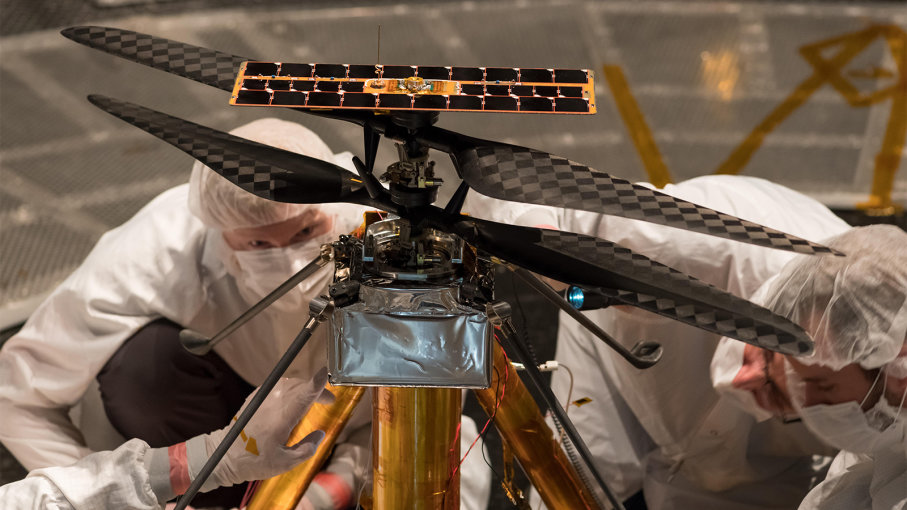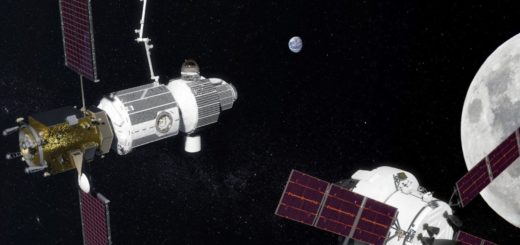Can a Helicopter Fly on Mars? NASA Says Yes

You might think that flying a helicopter on Mars is an outlandish, wildly improbable notion. Copters, after all, achieve lift by deflecting airflow with their rotor blades, as this Federal Aviation Administration handbook explains. And Mars doesn’t have a lot of air for doing that. Its thin atmosphere, in fact, is less than 1 percent of the volume of the atmosphere on Earth.
Well, if you think it can’t be done, NASA is out to prove you wrong. When the space agency launches its new Mars 2020 rover on a trip to the red planet in July 2020, it will have the Mars Helicopter, a miniature robotic aircraft, attached to it. The experimental helicopter, which is in the final phase of testing, weighs a little less than 4 pounds (1.8 kilograms) and its blades are around 4 feet (1.2 meters) long, from tip to tip. NASA researchers hope that it will achieve the first-ever flight of a heavier-than-air aircraft on the red planet.
NASA actually has been working on developing a helicopter that could fly on Mars for decades now, as Bob Balaram, the project’s chief engineer at NASA’s Jet Propulsion Laboratory near Pasadena, California, explains via email. But solving all the technical challenges was a daunting task.
“A helicopter for Mars has to be tough enough to survive the journey to Mars (high g-loads, vibration, etc.) and the environmental conditions it will face in space and upon arrival (nighttime cold, etc.),” Balaram says. “The design of such as vehicle also has to address the unique aerodynamics in the thin Martian atmosphere, which imposes challenging weight constraints on the vehicle design. It has been possible to meet these stringent mass constraints only recently, with the advent of lightweight electronics (e.g. cell-phone components), and battery technology (e.g. Lithium Ion cells).”
In order to achieve lift in an atmosphere that’s the equivalent of being 100,000 feet (30,400 meters) in altitude on Earth — more than twice the maximum height that helicopters have reached on this planet — the Mars copter’s blades will spin at 2,300-2,900 revolutions per minute, about 10 times faster than Earth helicopters do.
But achieving lift is just one of the things the copter must manage. It also has to be able to survive Mars’ brutally cold nighttime temperatures, which can get down to minus 100 degrees Fahrenheit (minus 73 degrees Celsius), according to Space.com. And it needs to be able to recharge itself, which it accomplishes via a built-in solar panel. And because of the lag time in transmitting electronic instructions from Earth, it can’t be guided by a human with a joystick back home. Instead, it will rely on onboard sensors.
The unit on the Mars 2020 mission is designed to demonstrate that flying on Mars is possible, rather than to conduct other research. But if it works as planned, future helicopters will be bigger and more capable. “The particular design chosen for the tech demonstrator (counter-rotating coaxial rotors) was to maximize performance for the available space on the Mars 2020 rover,” Balaram says. “Next generation science helicopters would use multi-rotor configurations with payload capability in the 0.5 to 2 kilogram (1.1 to 4.4 pounds) range. Vehicles sizes could typically be in the 20 to 30 kilogram (44 to 66 pounds) range. The main constraint would be to package the rotor blades and overall system into a configuration compatible with lander designs for Mars.”
Helicopters and other types of aircraft could be extremely useful to future Mars exploration, especially if they’re deployed in conjunction with robotic rovers on the planet’s surface.
“In particular, they are well-suited to taking cameras, sensors, and other instruments into terrains that are too extreme or unstable for surface rovers — high-angle slopes, cliffsides, very rough boulder-strewn terrain, extremely soft soils, etc.,” Dave Lavery, program executive for solar system exploration in NASA’s Planetary Science Division, explains via email. “Flying platforms can also enable the use of sensors across relatively large areas of terrain that would be prohibitively time consuming for a rover, or eventually a human, to cover,” such as obtaining detailed scans of 100-acre (40-hectare) tracts on the Martian surface. “They will also be useful for carrying small payloads, such as deploying small instruments throughout an area of science interest or retrieving samples and returning them to a central repository for analysis.”
You might think that orbital satellite images of Mars would serve to make aerial surveys of the Martian surface unnecessary, but an aircraft flying at a lower altitude could take even higher-resolution images and gather other useful data that a satellite’s instruments couldn’t manage. Satellite technology “is limited when a detailed close-up view of a particular region is desired,” Lavery explains. “By providing the option to fly a camera or sensor a few tens or hundreds of meters above the surface, instead of hundreds of kilometers, atmospheric platforms can enable very detailed views of selected regions of the planet.”
Helicopters could be a help to eventual human colonists on the red planet. “Additional tasks a Mars helicopter might perform include delivery of emergency supplies, or parts for repairs,” explains Dale Skran, in an email. He is chairman of the executive committee of the National Space Society, a nonprofit organization that advocates for space development and settlement. “However, perhaps the most significant benefit might be ultra-high quality, multi-spectral images to support the search for resources needed by future Martian settlers.”
Skran envisions future generations of copters with more sophisticated capabilities. “A fully or mostly autonomous helicopter, when combined with artificial intelligence-based data analysis, supports that rapid exploration and evaluation of potential resources on Mars with minimal human intervention,” he says. “This is critical since in the early days of Martian exploration and settlement, human labor will be in short supply.”
Lavery noted that robotic copters also could act as advance scouts for both rovers and astronauts exploring the Martian surface. By checking out the terrain and providing a visual preview, he says, “these scouts would improve the efficiency and safety of surface operations by eliminating hazardous or ineffective paths from consideration and avoiding ‘blind alleys’ that could not be identified by orbiting satellites.”



 Creators of mankind
Creators of mankind Description of “Tall white aliens”
Description of “Tall white aliens” Where they came from?
Where they came from? About hostile civilizations
About hostile civilizations The war for the Earth
The war for the Earth “Tall white aliens” about eternal life
“Tall white aliens” about eternal life Video: “Nordic aliens”
Video: “Nordic aliens” Aliens
Aliens Alien encounters
Alien encounters The aliens base
The aliens base UFO
UFO Technology UFO
Technology UFO Underground civilization
Underground civilization Ancient alien artifacts
Ancient alien artifacts Military and UFO
Military and UFO Mysteries and hypotheses
Mysteries and hypotheses Scientific facts
Scientific facts


















